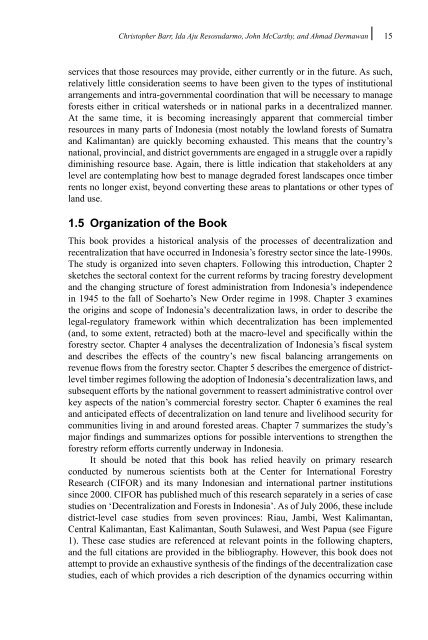Decentralization of Forest Administration in Indonesia, Implications ...
Decentralization of Forest Administration in Indonesia, Implications ...
Decentralization of Forest Administration in Indonesia, Implications ...
You also want an ePaper? Increase the reach of your titles
YUMPU automatically turns print PDFs into web optimized ePapers that Google loves.
Christopher Barr, Ida Aju Resosudarmo, John McCarthy, and Ahmad Dermawan 15<br />
services that those resources may provide, either currently or <strong>in</strong> the future. As such,<br />
relatively little consideration seems to have been given to the types <strong>of</strong> <strong>in</strong>stitutional<br />
arrangements and <strong>in</strong>tra-governmental coord<strong>in</strong>ation that will be necessary to manage<br />
forests either <strong>in</strong> critical watersheds or <strong>in</strong> national parks <strong>in</strong> a decentralized manner.<br />
At the same time, it is becom<strong>in</strong>g <strong>in</strong>creas<strong>in</strong>gly apparent that commercial timber<br />
resources <strong>in</strong> many parts <strong>of</strong> <strong>Indonesia</strong> (most notably the lowland forests <strong>of</strong> Sumatra<br />
and Kalimantan) are quickly becom<strong>in</strong>g exhausted. This means that the country’s<br />
national, prov<strong>in</strong>cial, and district governments are engaged <strong>in</strong> a struggle over a rapidly<br />
dim<strong>in</strong>ish<strong>in</strong>g resource base. Aga<strong>in</strong>, there is little <strong>in</strong>dication that stakeholders at any<br />
level are contemplat<strong>in</strong>g how best to manage degraded forest landscapes once timber<br />
rents no longer exist, beyond convert<strong>in</strong>g these areas to plantations or other types <strong>of</strong><br />
land use.<br />
1.5 Organization <strong>of</strong> the Book<br />
This book provides a historical analysis <strong>of</strong> the processes <strong>of</strong> decentralization and<br />
recentralization that have occurred <strong>in</strong> <strong>Indonesia</strong>’s forestry sector s<strong>in</strong>ce the late-1990s.<br />
The study is organized <strong>in</strong>to seven chapters. Follow<strong>in</strong>g this <strong>in</strong>troduction, Chapter 2<br />
sketches the sectoral context for the current reforms by trac<strong>in</strong>g forestry development<br />
and the chang<strong>in</strong>g structure <strong>of</strong> forest adm<strong>in</strong>istration from <strong>Indonesia</strong>’s <strong>in</strong>dependence<br />
<strong>in</strong> 1945 to the fall <strong>of</strong> Soeharto’s New Order regime <strong>in</strong> 1998. Chapter 3 exam<strong>in</strong>es<br />
the orig<strong>in</strong>s and scope <strong>of</strong> <strong>Indonesia</strong>’s decentralization laws, <strong>in</strong> order to describe the<br />
legal-regulatory framework with<strong>in</strong> which decentralization has been implemented<br />
(and, to some extent, retracted) both at the macro-level and specifically with<strong>in</strong> the<br />
forestry sector. Chapter 4 analyses the decentralization <strong>of</strong> <strong>Indonesia</strong>’s fiscal system<br />
and describes the effects <strong>of</strong> the country’s new fiscal balanc<strong>in</strong>g arrangements on<br />
revenue flows from the forestry sector. Chapter 5 describes the emergence <strong>of</strong> districtlevel<br />
timber regimes follow<strong>in</strong>g the adoption <strong>of</strong> <strong>Indonesia</strong>’s decentralization laws, and<br />
subsequent efforts by the national government to reassert adm<strong>in</strong>istrative control over<br />
key aspects <strong>of</strong> the nation’s commercial forestry sector. Chapter 6 exam<strong>in</strong>es the real<br />
and anticipated effects <strong>of</strong> decentralization on land tenure and livelihood security for<br />
communities liv<strong>in</strong>g <strong>in</strong> and around forested areas. Chapter 7 summarizes the study’s<br />
major f<strong>in</strong>d<strong>in</strong>gs and summarizes options for possible <strong>in</strong>terventions to strengthen the<br />
forestry reform efforts currently underway <strong>in</strong> <strong>Indonesia</strong>.<br />
It should be noted that this book has relied heavily on primary research<br />
conducted by numerous scientists both at the Center for International <strong>Forest</strong>ry<br />
Research (CIFOR) and its many <strong>Indonesia</strong>n and <strong>in</strong>ternational partner <strong>in</strong>stitutions<br />
s<strong>in</strong>ce 2000. CIFOR has published much <strong>of</strong> this research separately <strong>in</strong> a series <strong>of</strong> case<br />
studies on ‘<strong>Decentralization</strong> and <strong>Forest</strong>s <strong>in</strong> <strong>Indonesia</strong>’. As <strong>of</strong> July 2006, these <strong>in</strong>clude<br />
district-level case studies from seven prov<strong>in</strong>ces: Riau, Jambi, West Kalimantan,<br />
Central Kalimantan, East Kalimantan, South Sulawesi, and West Papua (see Figure<br />
1). These case studies are referenced at relevant po<strong>in</strong>ts <strong>in</strong> the follow<strong>in</strong>g chapters,<br />
and the full citations are provided <strong>in</strong> the bibliography. However, this book does not<br />
attempt to provide an exhaustive synthesis <strong>of</strong> the f<strong>in</strong>d<strong>in</strong>gs <strong>of</strong> the decentralization case<br />
studies, each <strong>of</strong> which provides a rich description <strong>of</strong> the dynamics occurr<strong>in</strong>g with<strong>in</strong>

















